Joy Neal Kidney's Blog, page 48
October 10, 2022
Melville No. 2 County School
Melville No. 2
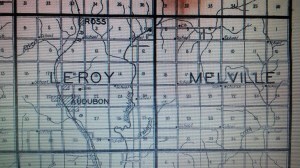 When the Goffs lived in Audubon County, Iowa, from 1906 to 1911, their youngsters attended Melville No. 2 school. Melville Township was just east of Leroy Township and the county seat town of Audubon. Audubon County is just west of Guthrie County.
When the Goffs lived in Audubon County, Iowa, from 1906 to 1911, their youngsters attended Melville No. 2 school. Melville Township was just east of Leroy Township and the county seat town of Audubon. Audubon County is just west of Guthrie County.
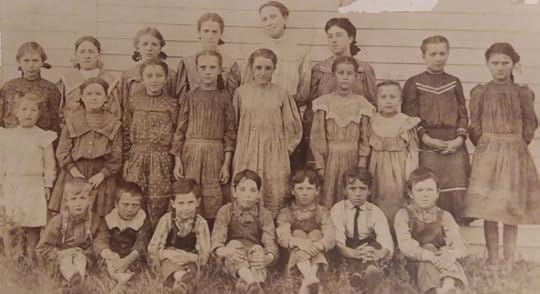 Melville No. II country school, Audubon County, Iowa, 1906 L-R: Back: Ruth Estes, Marguerite Foley, Georgia Goff, Alice Estes, Eleanor Ohm (teacher), Leora Goff, Maude Ruhs, Lulu Leavens. Middle: Ruby Goff, Clara Foley, Pearl Ruhs, Lila Leavens, Zells Smith, Genevieve Crees. Hilda Ruhs. Front: James Crees, Edward Leavens, ___ Estes, Harry Smith, Jennings Goff, Ambrose Foley, Rolla Goff. Absent: Merl and Wayne Goff, who were probably doing field work.
Melville No. II country school, Audubon County, Iowa, 1906 L-R: Back: Ruth Estes, Marguerite Foley, Georgia Goff, Alice Estes, Eleanor Ohm (teacher), Leora Goff, Maude Ruhs, Lulu Leavens. Middle: Ruby Goff, Clara Foley, Pearl Ruhs, Lila Leavens, Zells Smith, Genevieve Crees. Hilda Ruhs. Front: James Crees, Edward Leavens, ___ Estes, Harry Smith, Jennings Goff, Ambrose Foley, Rolla Goff. Absent: Merl and Wayne Goff, who were probably doing field work.
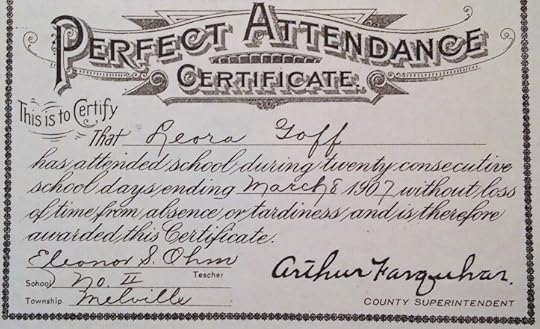
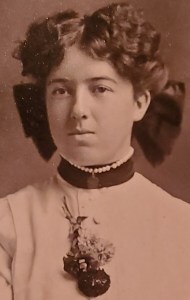 Leora Frances Goff, 8th Grade graduate, 1907
Leora Frances Goff, 8th Grade graduate, 1907At age 16, Leora Goff passed the eighth grade exam. Audubon County held exercises that June for 54 graduates of rural schools. The thirty who were present to receive their diplomas were urged not to be satisfied until they’d obtained a high school education.
Leora had hoped to continue in high school but Pa declared that as the oldest of ten children, she was needed on the farm to help feed them all, help with the laundry, and help with the younger ones. And help in the fields. Sherd promised to make sure his older kids were well-paid for their work instead of going to high school.
The spring after Leora graduated, the Audubon County Superintendent called for a day of house cleaning for the schools, with community help–floors, walls, windows, yards, outbuildings. This was likely a yearly tradition.
 Today Audubon County is in the process of placing historical markers where each of their country schools used to be. I requested to be the sponsor for the Melville No. 2 marker.
Today Audubon County is in the process of placing historical markers where each of their country schools used to be. I requested to be the sponsor for the Melville No. 2 marker.
October 7, 2022
Darcy Maulsby, Endorser for “Leora’s Early Years,” will give a Program Monday Evening about her own New Book
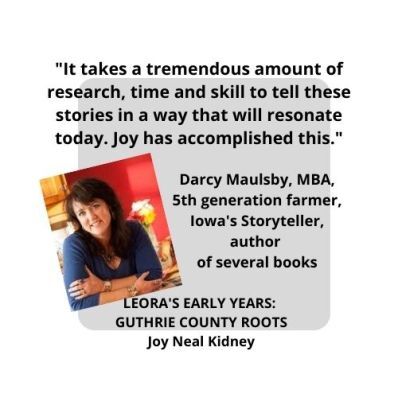 “So often, the histories of Iowa’s rural families are reduced to names and dates on tombstones, or simple facts listed in family genealogies, if they are preserved at all. Joy Neal Kidney has given us a gift with this remarkable book that shares the joys, heartbreaks and hopes of her Iowa ancestors as they built a life in Guthrie County and beyond. It takes a tremendous amount of research, time and skill to tell these stories in a way that will resonate today. Joy has accomplished this. Using the history of her family, she humanizes a pivotal era of Iowa history, when the horse-and-buggy days of the late 1800s gave way to the early twentieth century, an era filled with technological marvels and optimism for a brighter future.
“So often, the histories of Iowa’s rural families are reduced to names and dates on tombstones, or simple facts listed in family genealogies, if they are preserved at all. Joy Neal Kidney has given us a gift with this remarkable book that shares the joys, heartbreaks and hopes of her Iowa ancestors as they built a life in Guthrie County and beyond. It takes a tremendous amount of research, time and skill to tell these stories in a way that will resonate today. Joy has accomplished this. Using the history of her family, she humanizes a pivotal era of Iowa history, when the horse-and-buggy days of the late 1800s gave way to the early twentieth century, an era filled with technological marvels and optimism for a brighter future.
“Even if you’ve never attended a country school, lived on a farm or had an escapade at a jail (don’t miss that story!), you can relate to being a kid, enjoying the company of family and friends, losing a loved one, and experiencing simple pleasures in life, like music, fairs and holidays. While these stories will entertain you, they also honor the things that really matter in life—family, faith, service to community and country, resilience, and leaving a legacy of a life well lived.”
Darcy Dougherty Maulsby is Iowa’s Storyteller and part of family that operates a Century Farm in Calhoun County near Lake City and Yetter. She earned her journalism/communication degree and master’s degree in business administration (with a marketing emphasis) from Iowa State University. After working for several companies in the Des Moines area, including the Iowa Farm Bureau Federation and AgWeb.com, she became an entrepreneur and opened her own business; she has run her own marketing/communications company, Darcy Maulsby & Company, full time since 2002. Darcy is the author of several books, including A Culinary History of Iowa; Calhoun County; Classic Restaurants of Des Moines and Their Recipes; Dallas County, Iowa; Agriculture: A History of Farming, Family and Food; and Madison County.
Darcy’s website. Her Amazon Author Page.
Darcy will give a program about her new book, The Lincoln Highway in Iowa, Monday evening October 10 at 6:30, Artisan Gallery 218 in Valley Junction, sponsored by Beaverdale Books.
October 5, 2022
The Thornton W. Burgess “Mother Westwind” Stories
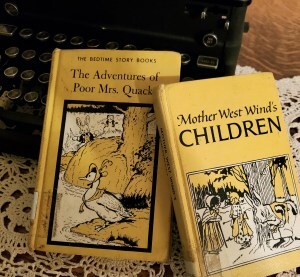
The Wilson family lived in Stuart, Iowa, during the 1920s. Twins Dale and Darlene were born there in 1921. The older children were Delbert (born in 1915), Donald (1916), and Doris (1918).
Leora had her hands full, and in the evening, her husband Clabe left for his job as Stuart’s night watchman. The one before him had been killed during a bank robbery attempt.
After Leora put the twins to bed, Doris was next, in a room just off the dining area. Leora left her door ajar so little Doris could hear her mother reading Mother Westwind stories to Delbert and Donald. An oil lamp glowed in the center of the round table, where they gathered. Doris, in her dark room, could picture each character–Sammy Jay, Reddy Fox, Jerry Muskrat, and all the many others.
Did your mother read bedtime stories to you? Which were your favorites?
—–

What were these stories my mother remembered from the 1920s? Stories of common animals, revealing their natures with charm and fascination, were the imagination of Thornton W. Burgess. Nature’s Ambassador by Christie Palmer Lowrance is a complete biography and legacy of Burgess, including several photos, comments by others, notes, a bibliography, and an index. This gem of a book is about an prolific author who wrote so many stories treasured for decades by children and adults alike.
Leora’s Early Years: Guthrie County Roots
October 3, 2022
Ed Goff Has Descendants After All
Sherd Goff was one of the seven children of John and Florence Goff. The youngest three died as children. The third and fourth both died at the age of 20. That left Eddie and Sherd (Edwin Carlton and Milton Sheridan). Eddie never married, so I told people that Sherd Goff’s children were the only grandchildren for. I was wrong!
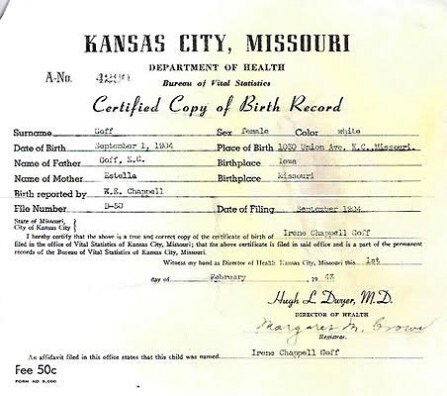
Last year I was contacted by a woman from Florida. She, her mother, and grandmother took DNA tests, which confirmed Eddie C. Goff as being part of their ancestry. E. C. Goff is listed as the father on the birth certificate of Irene Chappell Goff.
The great granddaugher had also learned that Ed Goff’s parents were John B. and Florence Ione (Shepherd) Goff, and wondered if I knew anything about the family. Well, Edwin Carlton Goff is listed on one of my family charts, the brother of my great grandfather.
I sent her what I knew about “Uncle Ed Goff,” which wasn’t much. I’d just learned that he was the mystery man on the right with other Goffs whom I recognized.
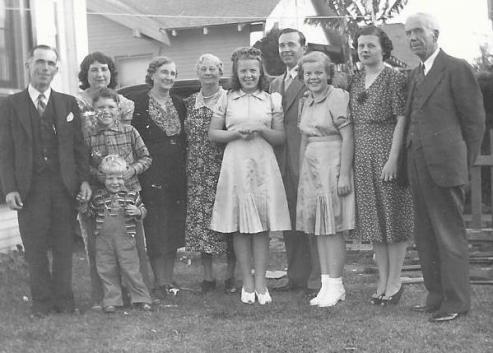 Wayne Goff, Ruby (Goff) Blockley with Curtis and Gary Blockley, Laura (Jordan) Goff, Wayne’s landlady. The next four are Willis Goff’s family: Connie, Willis, Shirley, and Anne. Ed Goff is on the right. He’s the brother-in-law of Laura, and the uncle of Wayne, Ruby, and Willis (who are siblings of Leora (Goff) Wilson). California.
Wayne Goff, Ruby (Goff) Blockley with Curtis and Gary Blockley, Laura (Jordan) Goff, Wayne’s landlady. The next four are Willis Goff’s family: Connie, Willis, Shirley, and Anne. Ed Goff is on the right. He’s the brother-in-law of Laura, and the uncle of Wayne, Ruby, and Willis (who are siblings of Leora (Goff) Wilson). California.The only one still living in the above photo is Gary Blockley. He remembered enough about tall quiet Uncle Ed that he and the young woman have had at least one phone conversation.
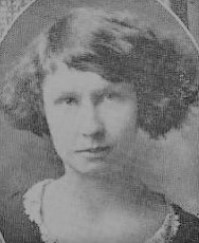 Irene Chappell, or Chappie Irene
Irene Chappell, or Chappie Irene
The young woman has her great grandmother’s diary and records. She named E. C. Goff as the father of her daughter, called “Chappie.” Ed used to bring her strawberries. “The last story is that Eddie left at the age of 37 with Florence and John on a railway when she was in labor at the hotel across the street and she never saw him again.”
Because this is her story to tell, I’m not naming the woman who contacted me, but said that she felt like I’d sent her a missing piece, that she, her mother, and grandmother were connected to a real family. “My mother and I actually just cried on the phone! What an emotional great day this is been! My great great grandmother was 35 when my great grandmother was born and Eddie was in his late 30s as well. While her diary says that he knew and she was in the late stages of her pregnancy when he left, it makes me wonder if he actually did. Why did he not ever marry? Oh how I wish I could go back in time! She describes him as handsome, tall and very gentle. There are some stories about him having to take care of his parents and that is why he left. My great grandmother told me that when her mother was in her older years that she built a fire in the backyard and burnt all of the letters that he had sent her.”
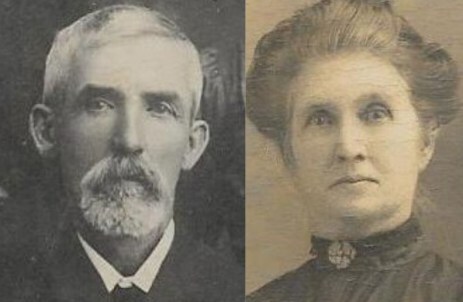 John Broderick and Florence Ione (Shepherd) Goff
John Broderick and Florence Ione (Shepherd) GoffEddie Goff pioneered with his parents in Montana. Did they know he was leaving a woman in labor with his own child?
Did he ever wonder whether he’d fathered a son or a daughter? After his parents had died, why didn’t he try to connect with them? He died an old man alone in California, with descendants still hoping to find him.
I was hunting for something else when I ran across a small tintype, identified by Leora (Goff) Wilson as Edwin Carlton Goff, so I asked if Sasha would like it. Yes, and she okayed this blog post which publicly connects Ed Goff to his descendants for the first time.
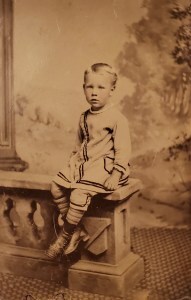 Edwin Carlton Goff
Edwin Carlton GoffI did not include this story in Leora’s Early Years: Guthrie County Roots. Ed Goff’s daughter was born while his brother’s family lived in northern Minnesota. I wonder whether Sherd Goff ever knew he had a niece about the same age as his younger sons.
September 30, 2022
Leora’s Early Years: Guthrie County Roots
Leora’s Early Years: Guthrie County Roots has become a reality!
During Leora Goff’s early decades, she gathered the tenacity, optimism and hope she would need throughout her long life. When she married Clabe Wilson, they became forged into parents who would shepherd their own family through two more great eras of world and local history–the Great Depression and WWII.
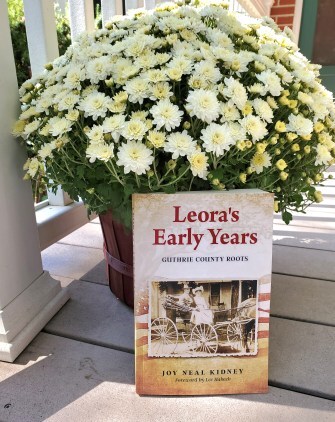
“Dive into these pages and experience adventures akin to Little House on the Prairie meets Our Town” wrote John Busbee, Founder of The Culture Buzz.
—–
Lee Habeeb wrote the Foreword. He is the founder and host for Our American Stories, heard locally over WHO Radio, but also podcast around the nation.
Lee asked how long I’d like the Foreword. I’m not fond of long ones, so told him that. The very next day I happily read one four pages long, so I quickly sent a note and said to write whatever he wanted. I think it’s longer than any chapter in the book, but is so fascinating.
A poem, “Morrisburg Cemetery,” is by Nicholas Dowd, who grew up in Guthrie Center. Grandma Leora knew his father, who was the town pharmacist at Dowd Drug.
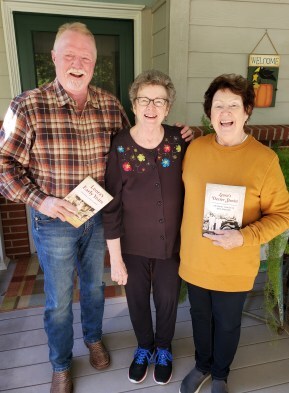 My grandfather Clabe Wilson had a sister, Alice (Wilson) McLuen. I met Alice’s granddaughter, Madeline, last year. Clabe and Alice’s parents (Dan and Georgia Wilson) are our mutual great grandparents. Stories of Clabe’s (and Alice’s) early years are part of the book, as well. It was a delight that they got the first copies of Leora’s Early Years: Guthrie County Roots.
My grandfather Clabe Wilson had a sister, Alice (Wilson) McLuen. I met Alice’s granddaughter, Madeline, last year. Clabe and Alice’s parents (Dan and Georgia Wilson) are our mutual great grandparents. Stories of Clabe’s (and Alice’s) early years are part of the book, as well. It was a delight that they got the first copies of Leora’s Early Years: Guthrie County Roots.
I’d ordered regular copies for first readers, endorsers, and encouragers, which I mailed out yesterday. I just realized that I didn’t keep a copy, but the “author copies” are to arrive by October 8.
—–
Autographed copies won’t be available locally until the week of October 10, but paperbacks, hardbacks, and ebooks (any day for ebooks) are “live” now on Amazon.
After October 10, autographed copies will be available in the Des Moines area at Beaverdale Books, the Urbandale Machine Shed Restaurant, and Off the Rails Quilting in Bondurant. Beaverdale Books offers shipping (515-279-5400)
Hear this, you elders; listen, all who live in the land.Has anything like this ever happened in your days
or in the days of your ancestors?
Tell it to your children,
and let your children tell it to their children,
and their children to the next generation.
Joel 1:2-3
September 28, 2022
Laura (Jordan) Goff Turns 92 (Leora’s mother)
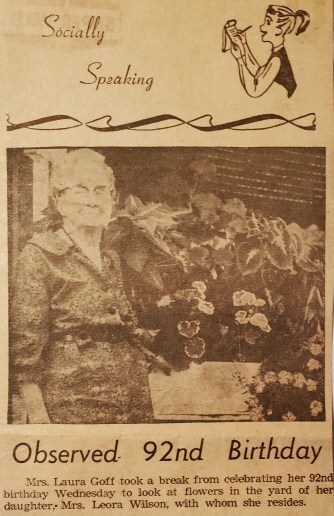
“One of Guthrie Center’s ‘young’ residents observed her 92nd birthday Wednesday [September 28, 1960], and many friends and neighbors called to extend congratulations, and many more unable to drop by or phone, sent cards.
“The celebrant was Mrs. Laura Goff, who has been a resident of this community for the past thirteen years. However she has been a Guthrie countian for many years of her lifetime.
“Beginning with her birth in a log cabin on a farm near Monteith, she grew up in that area and attended the schools in the county. After her marriage she resided in Nebraska for four years, and in Minnesota for two years, returning to Iowa and Guthrie county to again make her home. Mr. Goff died in 1930 and Mrs. Goff then resided in Omaha for 13 years, before returning to Guthrie Center to again take up her residency.
“Mrs. Goff has nine living children, and there are 12 grandchildren and 18 great grandchildren.
“Mrs. Goff feels a necessity to ‘keep on the go’ so that she will not get old with her years. She does the dishes each day for she [sic] and her daughter, Mrs. Leora Wilson, with whom she resides. She also takes complete care of her room, does cleaning and dusting in the home and goes for rides, and visits to the homes of her other children. As recent as two years ago Mrs. Goff accompanied her daughter, Mrs. Wilson to the west coast by plane to visit relatives.
“Daily papers are read by Mrs. Goff, as well as the local newspapers, and other magazines and literature which keeps her mind abreast of the activities of the community and world. She also hears well, and daily enjoys some television programs.
“Sunday, Merle [sic] Goff and daughter Phyllis, also Mr. and Mrs. Willis Goff and Mrs. Shirley McSharry and two children of Omaha joined Mrs. Goff for a birthday celebration in advance of the date.
“On Wednesday, grandchildren from Dexter and Earlham came to bestow regards to one of Guthrie Center’s grand ‘young, old ladies’.”
The Guthrie Center Times, September 29, 1960
Three of Laura Goff’s children lived in southern California: Wayne Goff, Ruby (Goff) Blockley, and Willis Goff.
Those daily TV programs were mostly “soap stories,” which were only 15 minutes at first, then grew to half an hour. The great grandchildren from Dexter were Joy and Gloria Neal. Those from Earlham were Richard, Robert, Dennis, and David Scar, the sons of Darlene’.
September 23, 2022
Gold Star Mother’s Day
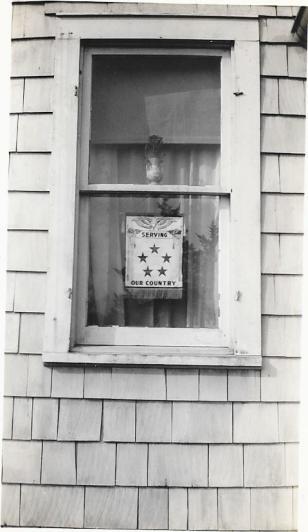 The five-star service flag in the farm home of Clabe and Leora Wilson near Minburn, Iowa, late 1943.
The five-star service flag in the farm home of Clabe and Leora Wilson near Minburn, Iowa, late 1943.The service flag is an official banner authorized by the Department of Defense for display by families who have members serving in the Armed Forces during any period of war or hostilities the United States may be engaged in.
A Blue Star family refers to one with a member in active service. A Gold Star means the loss of a family member in military service.
When Dale Wilson joined the Army Air Force in 1943, his mother Leora couldn’t find a service flag with three stars. Dale’s two older brothers were already in the US Navy.
Leora borrowed her mother’s three-star flag from WWI, when three Goff brothers served with the 88th Infantry Division in France.
Eventually all five Wilson brothers were helping with the war effort. Leora was able to buy a service flag with five blue stars.
With all five sons gone, Clabe could no longer take care of the landlord’s farm plus all the livestock, even with a hired man. The service flag moved with them when they bought a small acreage near Perry in late 1944.
In 1945, Leora pasted a gold star over one blue one when Junior was killed August 9. In early 1946, they received word of Danny’s death (which had occurred nearly a year earlier) and an official Declaration of Death (DOD) date was set for Dale Wilson. Leora reluctantly added two more gold stars.
After she was widowed and moved to Guthrie Center with her own mother, Leora Wilson was honored by the American Legion as a Gold Star Mother. Gold Star Mother’s Day is observed on the last Sunday of September as a day to recognize and honor those who have lost a son or daughter while serving the United States Armed Forces.
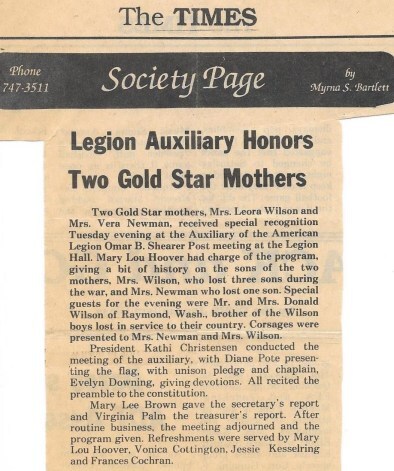

The Wilson family service flag is now owned by the Dexter Museum. All seven Wilson children grew up in Dexter during the Great Depression.
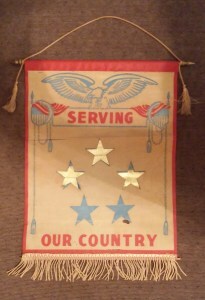
Leora’s Letters: The Story of Love and Loss for an Iowa Family During World War II
September 21, 2022
Tomato Recipes from the 1920s
When Doris Wilson was in third grade, back in the Roaring Twenties, the country kids ate dinner at school, since they couldn’t go home during the noon hour. They brought what their mothers had packed for them in metal pails.
“What’s that?” someone asked her. “It looks like blood!”
Doris’s mother made tomato butter, then used it for sandwiches, just like apple butter. Leora Wilson always made whole wheat bread. You can imagine slabs of bread with red stuff seeping out.

Tomato Butter
Cook peeled tomatoes down to puree. Add sugar and the slivered rind of oranges (Doris’s favorite) or lemons. Cook some more.
Raw Tomatoes
Doris’s father ate tomatoes with sugar and cream. Clabe’s family ate them that way when he was a child. He said they taste “just like strawberries” that way. (Doris was skeptical, even after she tried it that way.)
In late autumn, the kids could smell piccalilli when they came home from school. The pungent aroma also drew flies to the kitchen door, so Leora had the kids go around to the front door. They waited for her to unlock it and shoo the flies away with a dish towel.
Leora made piccalilli or chili sauce from chopped up vegetables and fruits from the the end of her garden, with sugar, spices, and vinegar.
Chili Sauce (or Piccalilli)1 peck ripe tomatoes
1/2 peck apples
1/4 peck onions
1 teaspoon cloves
1 teaspoon cinnamon
1 teaspoon allspice
2 tablespoons salt
1 quart vinegar
1 quart sugar
pepper - to suit taste (a red pepper is better)
Serve with any kind of meat.
Leora canned most of this concoction. Toward the end of the season, it included more apples.
From: Leora’s Early Years: Guthrie County Roots
September 17, 2022
Cover Reveal: Leora’s Early Years: Guthrie County Roots
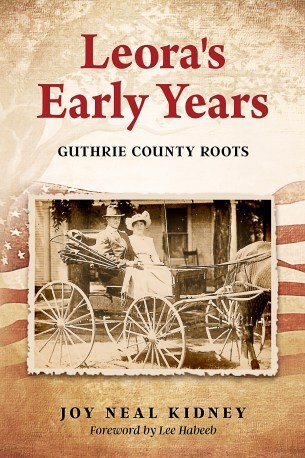
September 16, 2022
GI Night School and President Truman’s Platform
“Your dad and I helped make that platform for the president, you know.” Earnie and Dorothy Kopaska visited the Dexter Museum, which has a large display about the 1948 National Plowing Match. President Harry Truman gave a speech there that day, with an audience nearing 100,000 sweltering souls.
“Dad? Warren Neal? How did that happen?”
Earnie and Dad were both veterans of WWII and taking a class at GI Night School. They were asked to build the platform for the historic event. Dexter historian Bryon Weesner said that the platform was built with bridge deck planks upon 55 gallon oil drums.
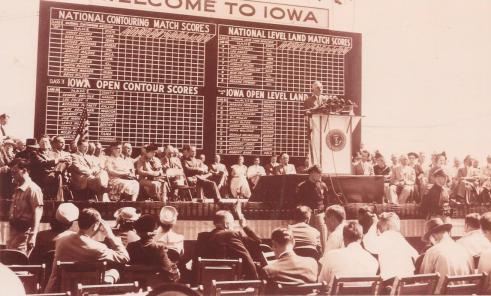 The platform was large enough for the row of those who brought the National Plowing Match to Dexter, Iowa. Dignitaries included Herb Plambeck of WHO Radio.
The platform was large enough for the row of those who brought the National Plowing Match to Dexter, Iowa. Dignitaries included Herb Plambeck of WHO Radio.I was a four-year-old that day, hoisted on Dad’s shoulders to see the man on the platform, but I’d never heard that story. After my folks bought the farm south of Dexter in 1952, I remember Dad’s being gone at night for those classes at the Dexter school, probably because Mom was a little more nervous about being alone with two small daughters in an unfamiliar neighborhood.
That night school was part of the GI Bill of Rights, passed in 1944, which provided funds for college or training for veterans after WWII. After the war, Mom wanted Dad to go to college, but he thought he was too old, at 27, with one child (me) already. He really wanted to farm.
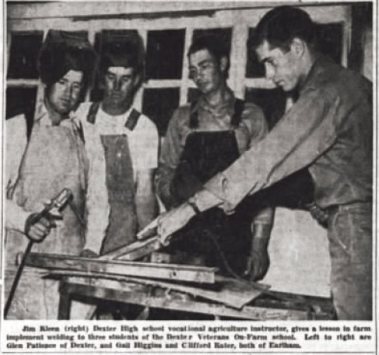
From Bryon Weesner: From June 1949. Dexter was one of many On-Farm schools that were created under the GI Bill after WW2. At one point there were 243 area farmers who had served in the war enrolled in classes at night. In the photo are Glen Patience, Gail Higgins, Clifford Rater and Ag Instructor at Dexter, Jim Kleen.
Earnest Kopaska was a 1947 graduate of Redfield High School. He dropped out of high school to serve in WWII, then returned to earn his diploma.
The tote boards from the 1948 National Plowing Match, part of the WELCOME TO IOWA backdrop on the stage, are now owned by the Dexter Museum. (“Museum season” is April through October.)




